I have admired the work of Los Angeles-based photographer and filmmaker Clifford Prince King from afar since discovering his exhibition while night comes on gently, held at the Hollywood contemporary art gallery STARS in 2020. Since then, King has exhibited multiple times in the US and Europe, while publications including Dazed, BUTT, The New York Times, Aperture and Fantastic Man have carried commissioned work and features. Now, Clifford is about to release his debut monograph, Orange Grove, published by TIS books.
I recently caught up with a sleepy Clifford by phone from his base in LA to discuss the role of domestic space in his practice, how it feels looking back on a collection of photographs made over several years, and how his audience should see the work as a “little thumbs up from the back”.
Adam Murray: Can you describe your experience living and working in Orange Grove after you moved there in 2016?
Clifford Prince King: Orange Grove is the street I lived on when I moved to Los Angeles. At that time, it felt very new and more of a realisation of myself. There was just total freedom to actually make the work that I always knew I wanted to make but didn’t necessarily have the environmental support or self-permission to do so. I felt very inspired and happy. Something just clicked where I wasn’t as shy, and I was just meeting people. Especially Black, queer people. It was a result of a certain feeling of openness.
AM: A lot of your images are set in domestic interiors. What significance does domestic space have in your work?
CPK: My apartment at the time was very empty, we didn’t have much furniture. Being queer and Black and single, I was meeting people, having casual sex and encounters and I was just documenting that. In a way, [I was] keeping a diary but instead of words, it was imagery.
It became a studio without having a studio. I’ve never really had a studio and when I first moved to LA the lighting was really beautiful at a certain time in my apartment. So, I just made my living space my studio.
I would take photographs of people and I would kind of protect their identity, just because more people aren’t openly trying to contribute, which is understandable. I think that it worked out better for me to conceal their identity, I feel like it adds a layer of mysteriousness that I enjoy.
The domestic space felt practical and easy to access, but in interiors, I feel like you’re able to be yourself a lot more. Especially queer, gay identity, you’re not necessarily expressing outdoors because the outdoors aren’t necessarily a safe space. So most interactions and connections are made inside. You have your own setup; you create that, people create that.


AM: Can you explain your own relationship to photography and what first motivated you to make pictures?
CPK: When I was younger, maybe eight or nine years old, I used to film with my dad’s VHS camcorder, the big camcorder that you’d put on your shoulder. Then I moved on to disposable cameras aged 12 or 13, then I took a film class in high school.
I’ve always had cameras. I think just having a camera was a segue I used in order to meet people. There was something in the middle between me and the person. It was an excuse to talk to someone or just be in front of someone without words being exchanged. I still think about that, it’s really nice actually.
AM: The text that accompanies your 2022 exhibition Raspberry Blow at Stars Gallery contains the line, “that the camera, its artifice exposed and integrated into habits of production and reception, can once again be trusted.” What role does trust play in your work?
CPK: It’s fluctuated, I think it depends on who I am photographing. Certain people I photograph have an expectation of where the photography might go. If it’s friends that I have now, I think they can understand that it has the potential to be seen. People who don’t know me, they have no idea where it could go, so I think I need to be mindful of this to protect them and myself. It is something that I’ve had to readjust to because I don’t want to put anyone in a position where they’re being seen without knowing.
“Being queer and Black and single, I was meeting people, having casual sex and encounters and I was just documenting that. In a way, [I was] keeping a diary but instead of words, it was imagery” – Clifford Prince King
AM: With your exhibitions and this new book, the work is made over several years. How do you feel when you look back on this collection of photographs?
CPK: It’s a release, to be honest. I wasn’t expecting the book to happen, but that work is a big part of myself and to have it displayed in exhibitions and this book, it feels like a nice way to end that part of my discovery and move on to other things but still have notes of that work because it is a specific part of me.
I think now, being a Black gay artist, even in figurative painting, there’s an expectation of what your work looks like and it’s obviously popular now and you can get pigeonholed. But overall I have a specific eye when making a photograph and it doesn’t just have to be a Black man laying in bed. It can be anyone and anything, it’s still my perception. It’s a good way to end that initial introduction into the art world but also move forward in a way that is not necessarily what’s expected of me.


AM: What role does audience play in your work?
CPK: I guess it comes down to representation. The work I make is the work I wish I had seen growing up, to make my process and my understanding easier. That links back to the faces being hidden in some images, I think it allows for people to put themselves in that photograph. The audience can relate to the circumstances and scenarios. My audience should see themselves within that, a little nod or thumbs up from the back. We’ve all been there.
AM: You mentioned that you feel you are moving on to slightly different ways of making work, what’s next? Where do you go from here with your practice?
CPK: I think I want to create something with more layers and meaning. I’m slowly obtaining resources to make more concrete decisions, be more intentional with what I want to put across. It all happened very quickly so now I’m just trying to figure out what I want to do next.
Orange Grove by Clifford Prince King is published by TIS books, and is out now.






